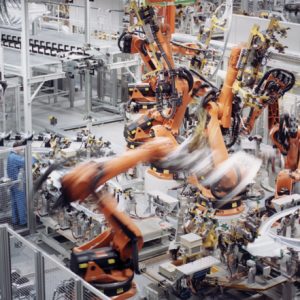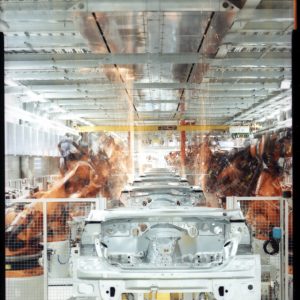Industry 4.0 and Energy 4.0 might sound like propagandistic plans straight from the pages of Pravda or the lexicon of bookworm revolutionaries, but according to Yanfei Li, an energy economist at the Economic Research Institute for Asean and East Asia, they are in fact simple and important ideas.
Industry 4.0 – otherwise known as intelligent manufacturing – has been the topic of conversation for journalists and academics for the past year or so, while Energy 4.0 is a concept developed by Yanfei himself.

“It’s an easy way for people to understand smart production and smart use of energy,” he said during a recent telephone interview with Focus Asean.
According to an earlier article he wrote for the Diplomat, Energy 4.0 refers to an imagined, future era of energy use. “The pre-oil era, the oil era, and the renewable energy era, as Energy 1.0, 2.0, and 3.0, respectively,” he wrote, adding that Energy 4.0 would become a reality when “smart production and energy use” comes to the foreground.
When asked to put his idea into simple terms, he explained: “Basically, it’s about using intelligent manufacturing and intelligent design as a way of managing energy use and protecting the environment.”
If this is still unclear, it might be easier to put it into practical terms. One example, Yanfei explained, is the use of intelligent manufacturing by the Chinese firm, Siasun Robot and Automation Company. It researches and develops industrial robot manufacturing, and automatic assembly and production lines.
In the company’s factories in Huzhou, Zhejiang province, the entire manufacturing process – consisting predominately of automotive parts – is conducted by robots. Automated mechanical arms assemble the parts, and programmed vehicles transport them around the factory. Whenever an order for assembly is placed, a computerised system, connected to the factory and its inventory, automatically sends out demands to the machines to begin the assembly.
Not only is this more productive – almost ten times compared to manual assembly – it could also be more ecological. In the future, Yanfei continued, this form of intelligent manufacturing could be connected to ‘smart grids’ and renewable energy sources so that clean energy can be produced and stored during times when the factory is less busy, and then used at peak times of consumption and production, thereby saving both energy and costs. 
Smart grids (explored in greater detail on page 20) are electricity supply networks that use advanced digital communications technology to detect and react to local changes in usage, altering the supply of electricity based on rises and falls in demand.
“This is just a vision, but already we have seen it in some European countries [and China],” he said. “As for Southeast Asia, there are some basic examples, but nowhere near being mature. We can see this with the introduction of smart grid systems in Singapore and Thailand.”
On Thailand’s Koh Samui island, for example, a smart grid system has been developed to provide a renewable energy supply.
“So what you have is the adoption of mature technology from other countries – that being smart grid systems from Europe and China – and integrating them with local conditions to promote the tourism industry, while at the same time preserving the natural environment so that the industry can prosper in the future,” he said.
One of the key parts of Yanfei’s Energy 4.0 concept is his insistence that Southeast Asian nations do not have to follow what others have done beforehand. They can, instead, leapfrog the stepping-stones of development.
A case in point, according to Yanfei, is the region’s rapid adoption of ICT. “Investing in ICT is much cheaper than investing in high-quality highway systems or high-speed railways,” he explained. “Many countries, including Indonesia, Vietnam and Malaysia, have relatively poor infrastructure, if you compare it to the likes of China and Japan, but ICT is developing in these countries very quickly.”
What this means, Yanfei claims, is that technology reduces the need for physical mobility. For example, if educational courses can be provided online, it means that people do not have to cross entire cities to attend classes.
This is just one basic example – and one that might appear trivial – but according to Yanfei it is an indication that Southeast Asian countries do not need to replicate what others have done beforehand – the development of heavy industry and considerable investment in physical infrastructure, for instance – in order to move to the next level of development.
“Maybe Southeast Asia can jump to the ‘next level’ and certain parts of the economy can bypass what other countries had to go through,” he said.
He admitted, however, that the region may be along way from making Energy 4.0 a reality.
But if it was to be introduced within the coming decades, it would not only be a economic boon for the region, speeding the pace of development and keeping up with the rate of the latest technologies. It would also be vitally important for the environment.
“Clean technologies and green industries should be given priority by Southeast Asian [governments and businesses]. It is these high value-added, high-efficiency industries that could drive the leapfrogging of income levels in the region,” he wrote in the Diplomat.
The success in manufacturing low-cost solar energy, wind turbines, smartphones, and robotics equipment in China, he added, shows how the business model of importing mature technologies – from Europe, Japan, and North America – and combining them with cheap local production factors can be successful.
“The only way to have concepts such as Industry 4.0 and Energy 4.0 in mind is by looking ahead, not with cheap, easy solutions, but with real long-term planning for the economy and society,” he said.


